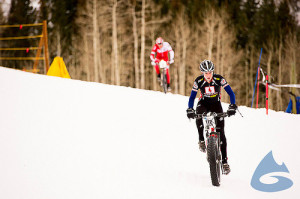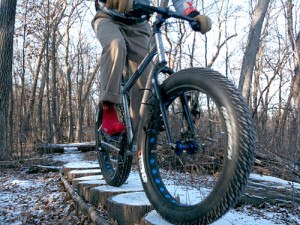Have you ever wandered into your local bike shop and seen a bike that just looks out of place? Kind of like a Franken-Bike? The tires are huge, the frame is heavy, you think it might be a mountain bike, but it comes with no suspension and a single speed freewheel. Enter the fat bike, a new cycling phenomenon that is quickly becoming a sub-culture of its own.
Where Did the Fat Bike Come from?
Gear Junkie wrote a review of fat bikes and said this:
Back then, the large-tire bikes were freaks, and they were made only by custom frame-builders who liked to pedal in snow. On snow, the wide tires have more surface area touching down and simply “float” a bit more rather than digging in like skinnier tires can. Finally, with all that squishy rubber under you, suspension is not necessary for most fat bikes. Wide rims, extra-large tires, and weirdly-dimensioned frames to make it all fit together define a fat bike, a cycling subcategory that’s garnered a serious following now in 2012. Bike shops report selling out of fat-bike stock. Brand managers at Surly and Salsa Cycles, another fat-bike maker owned by Minnesota’s QBP, have told me demand this year has overwhelmed supply.
From improved traction on dirt to flotation when riding through snow, these obese tires let a bike roll where it has not rolled before. The wide rubber —some fat tires are 4+ inches across, or twice as wide as most mountain-bike tire tread— adds notable grip on the ground, and the extra surface area does not allow the wheel to sink as much into soft surfaces like snow or sand.
 What’s the Cost?
What’s the Cost?
Usually custom jobs, fat bikes usually cost anywhere from $1,500 to $5,000. Though they are heavier than traditional mountain bikes and slower on regular terrain, the cost pays off in snow, on sand, and for some serious grip on dirt or rocky terrain, nothing else made compares to a fatty tire. The bikes have spurred a small revolution of biking on snow for long distances.
Global Fat Bike Summit
Everyone at the Global Fat Bike Summit made sure that the message was clear: fat biking is not a fad. Many statements in Summit presentations were preceded with, “I used to think differently about fat bikes, until I tried one.” The Summit provided the opportunity to throw a leg over the industry’s finest products for both the uninitiated and the disciple.
Bicycle Times Magazine said:
Although most of the seminars addressed issues surrounding winter use, it’s clear the movement does not want to be pigeon-holed as an on-snow recreation product. This is good news because we haven’t even begin to scratch the surface of fat bike year-round appeal. In fact as the segment matures I believe we’ll be seeing many more summertime uses begin to appear.
For more information on Fat Bikes and to see the options you have, visit Fat-bike.com

